Be There For The Other
SF in Training
Feb 1, 2022
Leah Davcheva, & Carey Glass, & Liselotte Baeijaert

Review by Carey Glass and Liselotte Baeijaert
Leah’s case study is an evocative story of an EU sponsored training course on SF coaching for young people drawn from various countries, set on an organic farm. The conception, development and implementation of the training course comes from a deeply considered application of SF principles, used imaginatively in the environment.
Some examples provide a flavour of the quality of the work:
- When developing the programme, Leah and her fellow practitioners, noticed and worked with their significant differences to enhance it.
- They used Open Space to honour and use the knowledge that the participants already brought to the course and the paths they wished to follow.
- With participants, the trainers spent time to develop well-formed questions with them to focus the learning.
- During the course, the trainers used the different spaces that the environment allowed to mark a sense of ongoing change.
Leah also demonstrated courage working live, trusting the process when a difficult situation arose. What comes across most profoundly is that she modelled the building of cooperation, curiosity and respect in an SF way, an attitude that would have left a deep and lasting impression for the participants to take forward.
Introduction
In what follows you will:
- Find out how a Solutions Focus (SF) training course – Coaching for Change – worked in terms of its usefulness for youth workers and for everyone involved
- Read about the ways we put into practice the fundamental assumptions and principles of SF work
- Consider the progress we all made
Section 1: Context and background
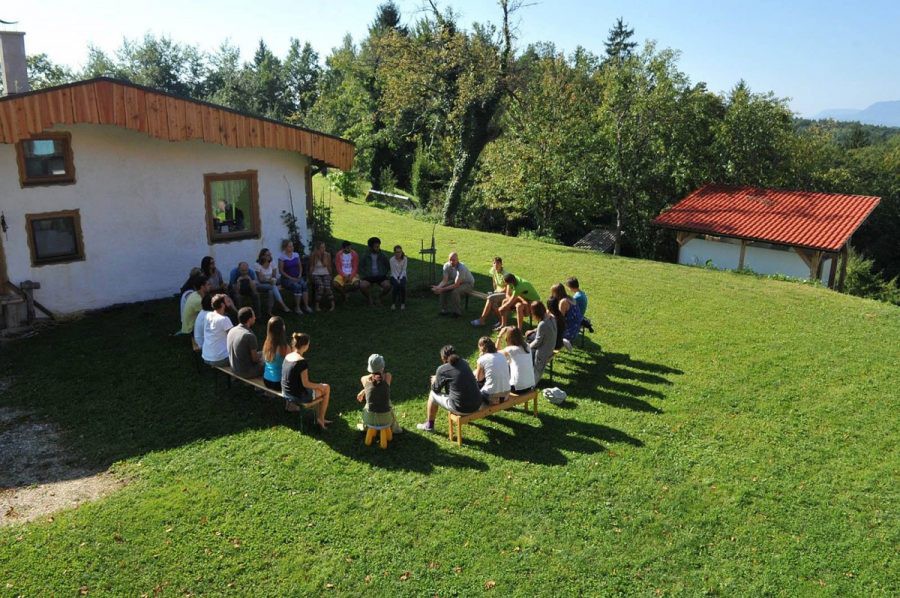
Place, venue, and space
Our course took place in Frankolovo, North-Eastern Slovenia. We all lived and worked on a small farm operated by a Slovenian partner organisation. The focal point of all interactions was a barn and the open spaces around it.
It would not be an exaggeration to say that in the eyes of all involved, the natural features of the place transformed from being breathtakingly beautiful scenery at the start of the course to a powerful ingredient in extending our understanding of the difference the course made to us all.
Time of year, weather, and duration
We got together at the end of August 2016 and ran almost all our activities in the open. For each of the sessions we changed the setting, thus naturally bringing in a very literal sense of flow and change. The course lasted a generous ten days.
Positioning the course
We mapped out the training event in-between three overlapping institutional, conceptual, and practice territories, namely:
- The format of an Erasmus+ project of the European Commission
- Our shared and individual understandings of SF coaching
- The experiences and resources of the course participants
Team of trainers – experience and expertise
Prior to initiating the design of the course, the three trainers (Biba Rebolj, Arpad Barnai and I) had not worked together. We deemed it necessary to establish some common ground – as solid as reasonably possible – so that we knew where in SF each one of us comes from, what our best hopes for the course were and how we imagined it happening. We discovered we shared a lot and, importantly, there were significant differences between us too. For example, the three of us came from diverse education and disciplinary homes, the organisations we represented had different profiles, our professional preoccupations were quite dissimilar. In addition, we had trained in three different schools of SF practice. We discovered we were using subtly different languages and had different ideas as to how to lay out the course. Although we did not have a clear-cut strategy how to manage them, we accepted and respected our particularities. As the course design gained speed, we were beginning to see these differences as complementary.
Client(s) and participants
Our corporate client was the Erasmus + Programme of the European Union. At the same time, we had our full attention on the young people who applied for the course. Participation was voluntary – people wanted to engage with the Solutions Focus approach and learn the practices of useful conversation.
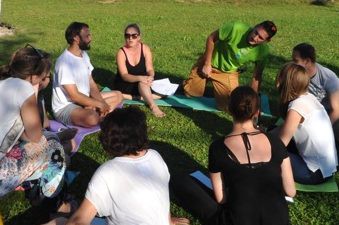
Preparing the course: four strands
Our task was a ten-day course to plan for. This amount of time, ample in our view, made it possible to set a fairly relaxed and measured pace of work. A prominent feature of our design was the interweaving of four strands of activities. We envisaged the participants:
- Experiencing SF through a series of team coaching sessions
- Learning to use some of the SF coaching tools, with a focus on
- The Platform
- Future Perfect
- Counters
- Affirms
- Scaling
- Small steps
- Practising conversations (in pairs and trios)
- Developing their own piece of work / project
Section 2: The work itself
Parameters of the work
We ran the course in roughly 34 sessions. Many of them flowed according to plan but there were also sessions which happened just because the need to have them emerged as we progressed. The trainers sat in on all sessions and collaborated as appropriate, no matter whether we were in the role of lead facilitator or not. Below is a description of some of the key sessions. The remaining sessions were devoted to practising conversations and mastering the use of the SF tools.
Open space
Open Space was preceded by a session devoted to Best Hopes the outcome of which was that the participants tuned into the main theme of the course, Coaching for Change, approaching it from their own personal perspectives.
We briefly introduced the practice of Open Space (Owen, http://www.openspaceworld.com/users_guide.htm)
The instructions were displayed on A3 posters so that everybody could see and refer to them. Making sure that the general outlines were clear, we announced the theme on which the participants were going to work – Coaching for change: a difference that can make a difference. Since the statement was strongly linked to the subject matter of the course the participants responded quickly. Sitting in a circle, they began proposing issues which were going to become focal points of the discussions they convened. The issues which got everybody interested were the following:
- What is coaching /a coach?
- How to learn / experience the practical tools of SF conversations?
- How to better identify the possibilities for change even with few resources
- Can coach and coachee be equal?
We made good progress. First and foremost, we had the groups interacting and sharing what was on their minds about coaching and change. We had their own collectively constructed map of the territories they were familiar with and also the ones they wanted to explore. Secondly, the aspiration that got them together in Frankolovo – to master the art of useful conversations – began acquiring voice and face as people got involved in discussions arising form their own personal take on the topic. And thirdly, our participants were re-assured that what they already knew and wanted to discover was going to be respected and acted upon.
Further, as facilitators, we had rich data to feed into the preparation of our next session and much better knowledge of their learning agenda.
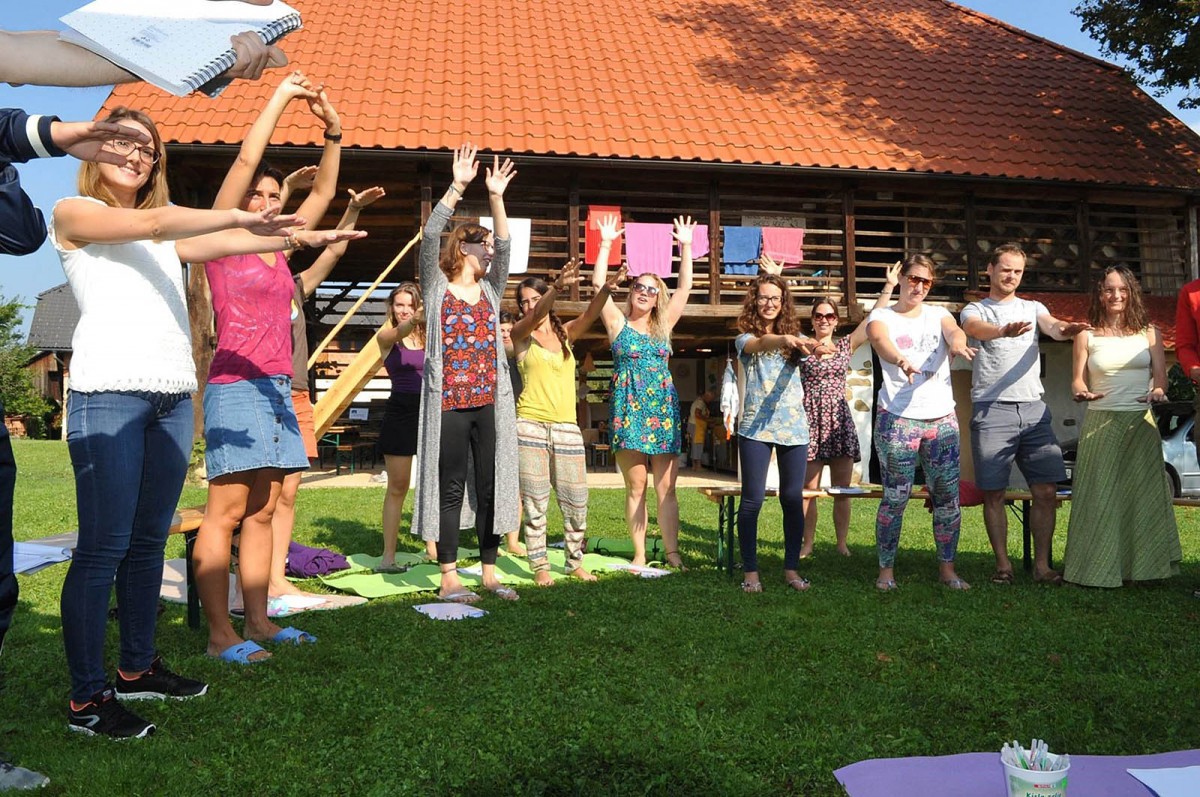
Solution Focus in Action
Solution Focus in Action was our core piece of work that arose from Open Space.
Before we started ‘in serious’ we opened the day with a 10-minute warm-up activity – The Resource (Whisper) Circle (Godat, 2008: 28-31). The purpose was to focus attention on resources in a playful way, and also, to demonstrate the use of an SF tool. The result was a much happier, wide-awake group to continue through the morning.
Reflection point 1
In the time between the course and writing this, I have become aware of an ongoing discussion over the practices of complimenting in Solutions Focus Brief Therapy (see Thomas, 2016) and the questions it poses regarding the “not-knowing” position.
And yet, with the wisdom of hindsight, I think that through this brief activity we added value to the growth of the team, in addition to demonstrating an SF instrument and remaining loyal to the common SF history. Time and space were just right.
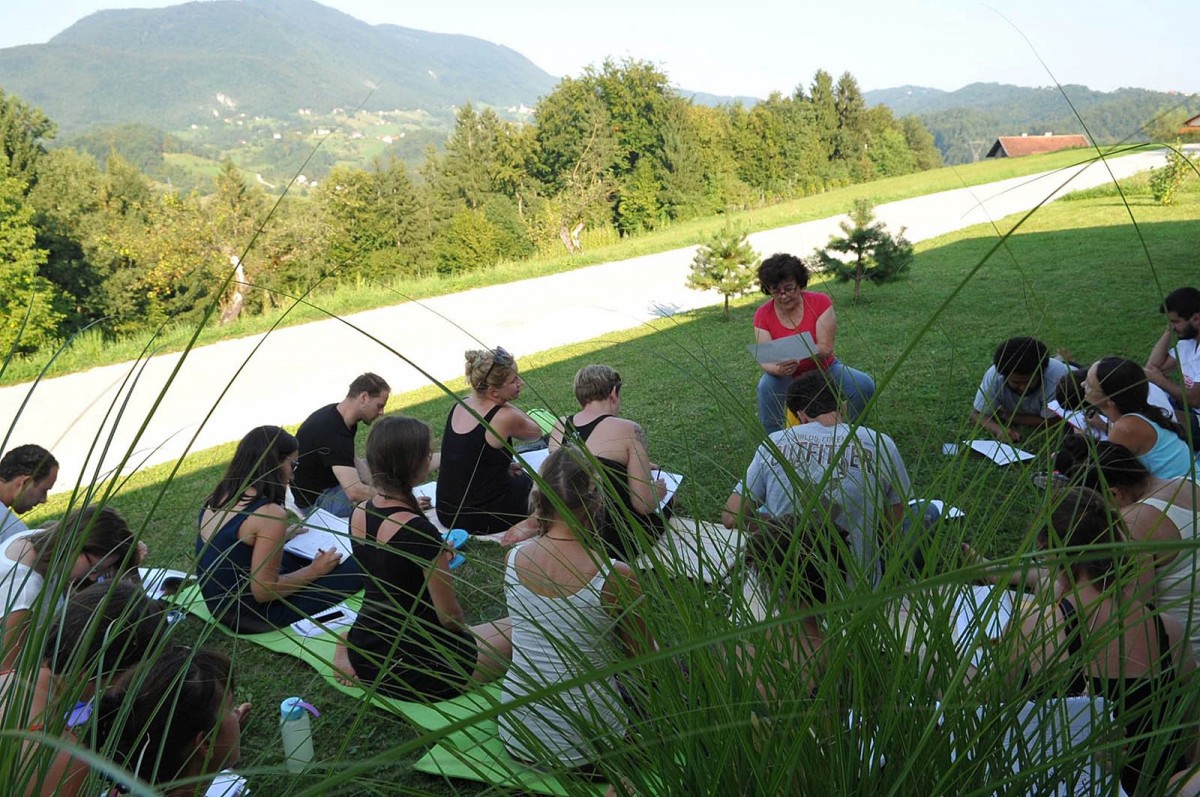
At this point, the participants encountered a full set of SF team coaching tools. Without being explicitly made aware of what the tools and their names were, they followed a solutions path, its stages marked by the use of each of the instruments.
At the start, participants chose from the menu of issues they had discussed the day before. Four groups shaped up around four themes.
The instructions handout (abridged) follows below:
“You and your group will have picked your theme of interest from the range of issues raised and discussed in Open Space yesterday.
- Regarding your chosen theme, what do we have to get right so that we turn the corner from problem to solution.
- Divide your sheet of paper into two parts.
- On the left side, write down: What works well?
- On the right hand side, write: What do we have to get right to move forward with this?
- The group scribbler writes down your suggestions and ideas. Once that is done, you want to give a NAME to your platform for change, deriving from the items on the right hand side. Do this by answering the question: What is a good name for the project / the change you want to have happen?
- Next, move on to your preferred future. What might it be?
- Supposing we were indeed to get all these things right, what would be happening?
This allows for the factors identified in the previous stage to be combined together into a working description of your desired future and / or a powerful visual. Present it on a separate sheet of paper.
The next thing you want to do is list the times when elements of your preferred future have already happened. Which ones? Even a little bit?
Your next move is to think and answer the following question: On a scale from 1 – 10, where 10 is your preferred future, where are you now (in the contexts that you work)? What is helping you to reach that level already?
What might the next small step up the scale look like? What might you need to do to get to it? We joined the groups, listening in and making sure the participants’ questions were answered and misunderstandings cleared. When all the groups completed their work, they each reported in plenary.
Reflection point 2
Here, I followed a format which I first saw acted out by Mark McKergow several years ago and had subsequently used many times, with teams and people in organisations.
At the end of the morning, we noticed signs of change. Firstly, the participants’ ideas and experiences surfaced, mingled and mixed, and a collective ground was created for the seeds of SF to grow. Secondly, nearly all the groups stayed on the level of description rather than interpretation, i.e. “describing what is openly observable” and not being “tempted to think that there are things hidden away” (de Shazer, 1988: 187). And thirdly, our participants experienced, for the first time, a process of SF team coaching whereby five of the SF tools were used. We noticed (and heard) that some of the participants demonstrated new patterns of thinking. And they all managed to stay on track.
In the last part of this session, we made a brief overview of the tools. To help visualise the process, we used a diagram from Jackson and McKergow (2007: 127).
Demo coaching and Building the Platform
The session on Building the Platform based on Step 1, did not go according to plan. Halfway, some of the participants began fidgeting, others exchanged bemused looks, and the rest voiced their frustration. They said they were lost and did not know what was going on. Clearly, it was a moment of crisis. We found ourselves in an emergency situation whereby we had to respond quickly. I volunteered to do a mini coaching session by way of demonstrating how the “journey in our quest for what works begins” (Jackson and McKergow, 2007:27). The person whose voice of protest was the loudest, was happy to be my ‘client’ in the demo session.
Soon the demonstration was underway and as soon as we finished, we noticed that the fog of frustration and uncertainty had lifted. There was a long moment of silence as people were reflecting on what they had just seen and heard.
Reflection point 3
This unexpected move and rapid change of plans seemed to be a good sign that we worked in an SF way. A session designed before the course, did not work. We tried something else and at the same time trusted the participants that they knew what was best for them at that particular moment in time.

Drawing upon the collective experience of the demo session and the first stage in the SF in Action session, we continued our work on the first of the SF tools. Using the Platform. Problem Talk and Solutions Talk, an exercise based on Mark McKergow’s examination of the tool (Jackson and McKergow, 2007: 22-32), was of benefit here.
Several concepts and points came up as especially useful:
- Distinguishing between problem talk and solution talk
- Amplifying useful change, illustrated by Paolo Terni’s story On Catching the Big Wave (2012: 8-9)
- Having a customer for change
- Platform-building questions
- The importance of language – simple, generating a sense of possibility and resources
At the end of the session we briefly took the participants through the rest of the SF tools for a second round.
Reflection point 4
The rationale for doing a second round of the SF tools was to support the participants in positioning the Platform within the bigger set of tools.
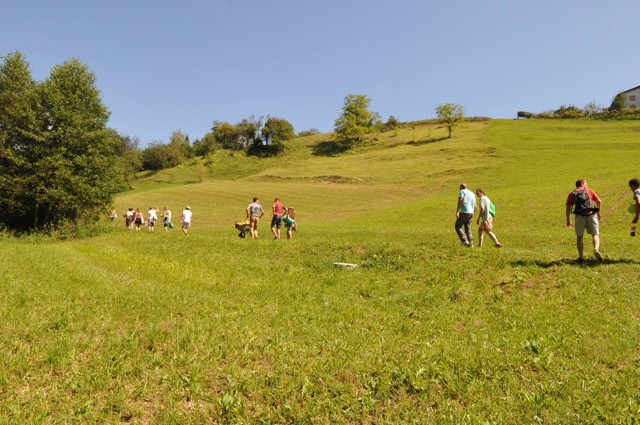
Socratic walk
The next session was Socratic Walk. It linked with The Harvest session later.
We started and finished on the lawn between the house and the Barn. For the rest of the time, the participants chose their own walking routes. The session lasted two hours.
Through this session we initiated the fourth strand in our course work, whereby the participants developed their own piece of work – something they were already doing and / or had in mind to do. In this session, the participants constructed, both individually and together, a bridge between the course reality and the realities of their lives and the work they were involved in.
While they walked, in pairs, the participants told each other about their initiative: who they were thinking of doing it with; who for; who would benefit; what; when; how long; where, and how. In plenary, they shared the benefits of the walk.
Reflection point 5
This session turned out well. The way it was set provided change of scenery and pace. The conversation was loosely formatted. Its frame encouraged the course participants to share with their walking partner what it was that they had already learned from the course and could use in a ‘real’ situation. The rhythm and energy of the activity seemed to have fostered good conversations as when they came back, the participants reported having made progress in shaping their ideas.
The Harvest: Acting upon my new knowledge, understanding and wisdom
In this session, the participants managed to turn the course experience into ready-to-use knowledge and get ready for action.
At different stages in the working process, people sat either in one big circle or in several smaller circles, or worked on their own. We were prepared to be quite flexible with time.
Each of the participants briefly outlined their intended piece of work on A1 paper. They were offered a choice of two work modes:
Reflecting teams (Norman, 2003)
Colourful affirms (using light, brightly coloured balls).
Those who chose Reflecting teams split into teams of 3-4 people. They followed a rigorously defined process of interaction and had the chance to experience one more SF tool.
In the Colourful affirms groups, members took turns to present their ‘project’ trying also to highlight the SF elements in it. Presentations lasted 7-8 minutes each. When the members of the group were convinced that the project was conceived and designed in the ethos of SF they lightly threw a coloured ball towards the presenter, thus affirming them.
Reflection point 6
The Harvest and the participants’ engagement with their own and the ideas of their friends demonstrated that their learning was going full on and was being applied successfully.
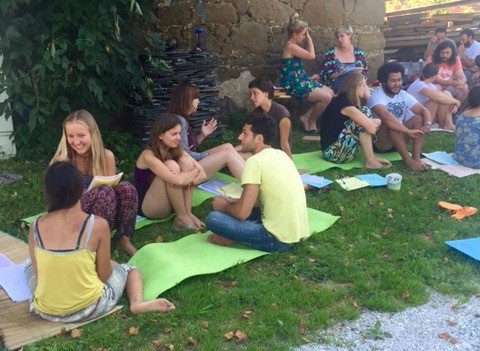
Section 3: Types of outcomes that arose
Regarding the course purpose and objectives:
The participants experimented with the SF tools and the various SF questions in conversation with each other and with their external ‘clients’. They tried SF coaching in the world outside the safe environment of the farm. Through a youth organisation, they met young people from Ljublyna who volunteered to be coached. They developed their projects employing SF thinking and use of the tools. Some of the participants were beginning to see and talk about the difference SF might make to achieve progress in difficult situations. They were open and at ease talking about the impression the course made on them. They readily gave us feedback, asked questions, responded to everything that was going on. It was remarkable how fast they learned the language of SF, e.g. the names of the tools, ways to formulate questions, ways to imply respect and appreciation. They were keen to start practising SF conversations with each other and with their external ‘customers’ from an NGO in Ljublyana.
Section 4: Voices of the participants
Life has become different and critical changes have occurred
I live a more fulfilling life. I changed university and my degree as well – instead of going on with philosophy I took a Master’s in development and management of human resources.
### Understanding Solutions Focus
[ …] the coach is leading you to talk about something that you want. So, it’s not only the ownership side of the equation, it’s also about the pleasurable side of the equation. You talk about something that you are really passionate about. When you like it, you are willing to work hard and invest in the coaching session.
Being a coach For me, being a coach is not being a helper. If you help somebody you patronise them. That means that they are not the expert. You are the expert and they are somewhere lower and it’s as if you are pulling them up. […]
Once the advice was out of the picture, the ‘helper’ was not working anymore. It had to go as well. And I reframed my interaction with the client. Not being a helper to them but rather an explorer of their resources and capabilities. This makes it fun for me.
I realised that it was not up to the coach, it was not about the personality of the coach or how experienced they are. It is about how able they are to stick to this method and to these questions. We are not masters of this language of neutrality yet.
A range of solutions
I also realised that I was coming from a solution deficit view point which means I believed there was only one solution. To a pattern of problems – this is the solution. To another pattern of problems – this is the solution. If you have this mindset, a person can’t form their own solution. It was really liberating for me to realise that the solutions are as many as the people are.
Addressing assumptions and subsequent changes
Now, I tend not to give advice and accept that the solutions which people come up with are good for them, even if it doesn’t make any sense for me.
Moving forwards
I use the SF approach with youngsters who might go to Syria.
After this course, I started using SF coaching in the project “School of second opportunities of education for youth in the youth guarantee” in the Spanish Red Cross.
Co – Trainers
This work was undertaken with two other trainers: Biba Rebolj and Arpad Barnai whom I would like to thank sincerely. I am also grateful to all the course participants for their enthusiasm and desire to learn.
REFERENCES
de Shazer, S. (1988). Clues: Investigating solutions in brief therapy. New York: Norton.
de Shazer, S. & Dolan, Y. (2007). More than miracles. New York: Routledge.
Godat, D. (2008). Resource telephone. In Röhrig, P. & Clarke, J. (Eds.) 57 SF activities for facilitators and consultants. Cheltenham: Solutions Books. (pp 28-31]
Jackson, P.Z. & McKergow, M. (2007). The Solutions Focus. London: Nicholas Brealey.
McKergow, M. (2011). Language, complexity and narrative emergence: Lessons from Solution Focused practice. In Tait, A. and Richardson, K.A. (Eds). Moving Forward with Complexity. (pp. 309-327). Litchfield Park AZ: Emergent Publications, ISBN 978-0984216598
Norman, H. (2003). Solution-Focused Reflecting Teams. In: O’Connell, B. & Palmer, S. (Eds.) Handbook of Solution-Focused Therapy (pp.156-168). London: Sage
Owen, H. A Brief User’s Guide to Open Space technology, retrieved January, 23, 2017 from http://www.openspaceworld.com/users_guide.htm
Terni, P. (2012). Mr. Bear Wants to Be Loved. ISBN 978-0-9855920-0-4
Thomas, F. (2016). Complimenting in Solution-Focused Brief Therapy. Journal of Solution-Focused Brief Therapy. 2, (1).1-22.
About the author – Leah Davcheva – PhD
Leah is the founder and director of AHA moments – Centre for Interculturality, Solutions Focus, and Host Leadership. She works both locally and internationally, developing and delivering coaching and training programmes for organisations, teams and individuals in a wide range of settings.
Leah has contributed to and was instrumental in building up the foundations of intercultural education and intercultural communication training in Bulgaria and beyond. Having studied Solutions Focus and Host Leadership with Mark McKergow, a more recent focus in her work is supporting people in their desire to change.
She is a researcher, and (co-) author of books, articles and learning materials